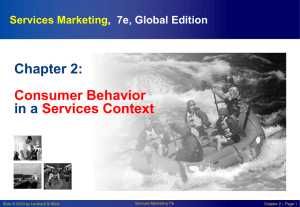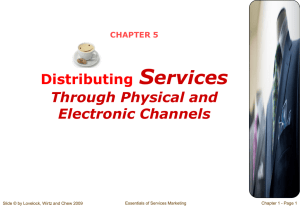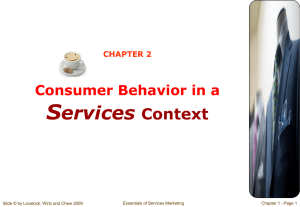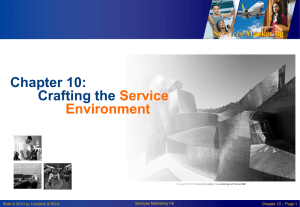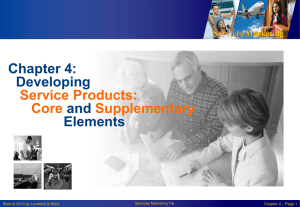Service Encounter Stage
advertisement
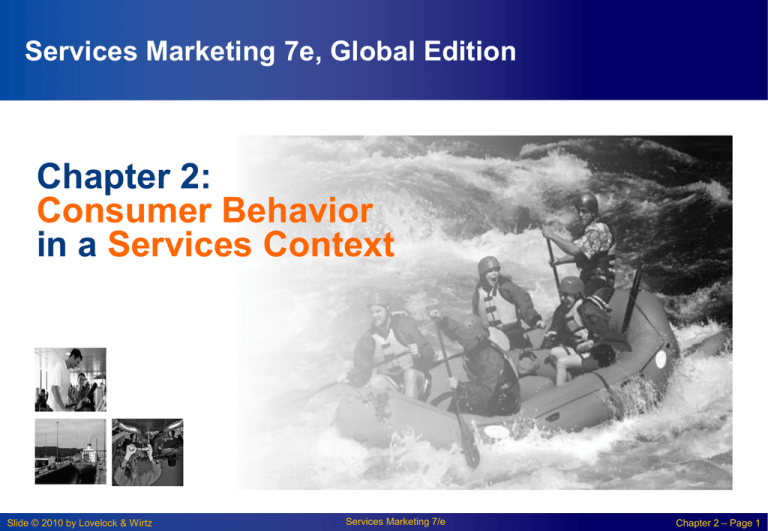
Services Marketing 7e, Global Edition Chapter 2: Consumer Behavior in a Services Context Slide © 2010 by Lovelock & Wirtz Services Marketing 7/e Chapter 2 – Page 1 Overview Of Chapter 2 Customer Decision Making: The Three-Stage Model of Service Consumption Pre-purchase Stage Service Encounter Stage Post-encounter Stage Slide © 2010 by Lovelock & Wirtz Services Marketing 7/e Chapter 2 – Page 2 Definition : Consumer Behavior Consumer Behavior : Consumer behavior is the study of individuals, groups, or organizations and the processes they use to select, secure, and dispose of products, services, experiences, or ideas to satisfy needs and the impacts that these processes have on the consumer and society. Slide © 2010 by Lovelock & Wirtz Services Marketing 7/e Chapter 2 – Page 3 Pre-purchase Stage Slide © 2010 by Lovelock & Wirtz Services Marketing 7/e Chapter 2 – Page 4 Pre-purchase Stage - Overview Pre-purchase Stage Customers seek solutions to aroused needs Evaluating a service may be difficult Service Encounter Stage Post-encounter Stage Slide © 2010 by Lovelock & Wirtz Uncertainty about outcomes Increases perceived risk What risk reduction strategies can service suppliers develop? Understanding customers’ service expectations Components of customer expectations Making a service purchase decision Services Marketing 7/e Chapter 2 – Page 5 The pre- purchase process of consumers in services Evaluation of predicted Need Arousal Information Search quality performance Service Expectations Evaluation of alternatives Knowledge Internal Slide © 2010 by Lovelock & Wirtz External Purchase Decision Services Marketing 7/e Chapter 2 – Page 6 Need Arousal Decision to buy or use a service is triggered (caused) by need arousal Consumers are then motivated to find a solution for their need Courtesy of Masterfile Corporation Slide © 2010 by Lovelock & Wirtz Services Marketing 7/e Chapter 2 – Page 7 Information Search Need arousal leads to attempts to find a solution Evoked(suggested) set – a set of products and brands that a consumer considers during the decision-making process – that is derived from past experiences or external sources Alternatives then need to be evaluated before a final decision is made Slide © 2010 by Lovelock & Wirtz Services Marketing 7/e Chapter 2 – Page 8 Evaluating Alternatives – Service Attributes High in Search Attributes(quality) help customers evaluate a product before purchase E.g., type of food, location, type of restaurant and price High in Experience Attributes cannot be evaluated before purchase The consumer will not know how much she/he will enjoy the food, the service, and the atmosphere until the actual experience High in Credence Attributes are those that customers find impossible to evaluate confidently even after purchase and consumption E.g., hygiene(cleanliness) conditions of the kitchen and the healthiness of the cooking ingredients (elements) Slide © 2010 by Lovelock & Wirtz Services Marketing 7/e Chapter 2 – Page 9 How Product Attributes Affect Ease of Evaluation Most Goods Most Services Easy To Evaluate Difficult To evaluate Clothing Restaurant Meals Computer Repair Chair Lawn Fertilizer Education Motor Vehicle Haircut Legal Services Foods Entertainment Complex Surgery High In Search Attributes High In Experience Attributes High In Credence Attributes Source: Adapted from Valarie A. Zeithaml , “How Consumer Evaluation Processes Differ Between Goods & Services,” in J.H. Donelly and W. R. George, Marketing of Services (Chicago: American Marketing Association, 1981) Services Marketing 7/e Chapter 2 – Page 10 Slide © 2010 by Lovelock & Wirtz Components of Customer Expectations Desired Service Level • wished-for level of service quality that customer believes can and should be delivered Adequate(acceptable) Service Level • minimum acceptable level of service without being dissatisfaction Predicted Service Level • service level that customer believes firm will actually deliver Zone of Tolerance • Acceptable range of variations in service delivery. “The zone of tolerance is usually defined as the range of customer perceptions of a service between desired and minimum acceptable standards ( Zeithaml, Berry, and Parasuraman, 1993 ). Slide © 2010 by Lovelock & Wirtz Services Marketing 7/e Chapter 2 – Page 11 Purchase Decision Purchase Decision: Possible alternatives are compared and evaluated, whereby the best option is selected Simple if perceived(suppose) risks are low and alternatives are clear Complex when trade-offs increase Trade- offs are often involved: “A balance achieved between two desirable but incompatible features”; a compromise. After making a decision, the consumer moves into the service encounter stage Slide © 2010 by Lovelock & Wirtz Services Marketing 7/e Chapter 2 – Page 12 Service Encounter Stage Slide © 2010 by Lovelock & Wirtz Services Marketing 7/e Chapter 2 – Page 13 Service Encounter Stage - Overview Pre-purchase Stage ● Service encounters range from highto low-contact ● Understanding the servuction system Service Encounter Stage ● Theater as a metaphor for service delivery: An integrative perspective Service facilities Personnel Post-encounter Stage Slide © 2010 by Lovelock & Wirtz Role and script theories Services Marketing 7/e Chapter 2 – Page 14 Service Encounter Stage Service encounter – a period of time during which a customer interacts directly with the service provider Might be brief or extend over a period of time Models and frameworks: 1. “Moments of Truth” – importance of managing touchpoints 2. High/low contact model – extent and nature of contact points 3. Servuction model – variations of interactions 4. Theater metaphor (symbol) – “staging” service performances Slide © 2010 by Lovelock & Wirtz Services Marketing 7/e Chapter 2 – Page 15 Moments of Truth “We could say that the perceived quality is realized at the moment of truth, when the service provider and the service customer confront one another in the arena(ground, stadium). At that moment they are very much on their own… It is the skill, the motivation, and the tools employed by the firm’s representative and the expectations and behavior of the client which together will create the service delivery process.” Richard Normann Web Define: A time when a person or thing is tested, a decision has to be made, or a crisis has to be faced. Slide © 2010 by Lovelock & Wirtz Services Marketing 7/e Chapter 2 – Page 16 Moments of Truth : Slide © 2010 by Lovelock & Wirtz Services Marketing 7/e Chapter 2 – Page 17 Distinctions between High-Contact and Low-Contact Services High-Contact Services Low-Contact Services Customers visit service facility and remain throughout service delivery Active contact Includes most peopleprocessing services Slide © 2010 by Lovelock & Wirtz Little or no physical contact Contact usually at arm’s length through electronic or physical distribution channels Facilitated by new technologies Services Marketing 7/e Chapter 2 – Page 18 Service Encounters Range from High-Contact to Low-Contact Slide © 2010 by Lovelock & Wirtz Services Marketing 7/e Chapter 2 – Page 19 The Servuction System: Service Production and Delivery Servuction System: visible front stage and invisible backstage Service Operations Technical core where inputs are processed and service elements created Contact people Inanimate environment Service Delivery Where “final assembly” of service elements takes place and service is delivered Includes customer interactions with operations and other customers Slide © 2010 by Lovelock & Wirtz Services Marketing 7/e Chapter 2 – Page 20 The Servuction System Source: Adapted and expanded from an original concept by Eric Langeard and Pierre Eiglier Slide © 2010 by Lovelock & Wirtz Services Marketing 7/e Chapter 2 – Page 21 Theater(Hall) as a Metaphor(symbol) for Service Delivery “All the world’s a stage and all the men and women only players. They have their exits and their entrances and each man in his time plays many parts.” William Shakespeare As You Like It Slide © 2010 by Lovelock & Wirtz Services Marketing 7/e Chapter 2 – Page 22 Theatrical Metaphor: an Integrative Perspective Good metaphor(symbol) as service delivery is a series of events that customers experience as a performance Service facilities Personnel (staff) • Stage on which drama unfolds(explain) • This may change from one act to another • Front stage personnel are like members of a cast • Backstage personnel are support production team Roles Scripts • Like actors, employees have roles to play and behave in specific ways • Specifies the sequences of behavior for customers and employees Slide © 2010 by Lovelock & Wirtz Services Marketing 7/e Chapter 2 – Page 23 Implications(not expressed) of Customer Participation in Service Delivery Greater need for information/training Help customers to perform well, get desired results Customers should be given a realistic service preview in advance of service delivery This allows them to have a clear idea of their expected role and their script in this whole experience Manages expectations and emotions Slide © 2010 by Lovelock & Wirtz Services Marketing 7/e Chapter 2 – Page 24 Post-Encounter Stage Slide © 2010 by Lovelock & Wirtz Services Marketing 7/e Chapter 2 – Page 25 Customer Satisfaction with Service Experience Satisfaction: attitude-like judgment following a service purchase or series of service interactions Whereby customers have expectations prior to consumption, observe service performance, compare it to expectations Satisfaction judgments are based on the below comparison Positive disconfirmation: (if the service is better than expected) Confirmation : (if it is as expected) Negative disconfirmation : ( If it is worse than expectation) Slide © 2010 by Lovelock & Wirtz Services Marketing 7/e Chapter 2 – Page 26 Customer Delight(enjoyment): Going Beyond Satisfaction Research shows that delight is a function of three components Unexpectedly high levels of performance Arousal (e.g., surprise, excitement) Positive affect (e.g., pleasure, joy, or happiness) Strategic links exist between customer satisfaction and corporate performance By creating more value for customers (increased satisfaction), the firm creates more value for the owners Slide © 2010 by Lovelock & Wirtz Services Marketing 7/e Chapter 2 – Page 27 Customer Delight: Going Beyond Satisfaction Best Practice in Action 2.1: Turkish Delight: Back-Up Company Offers Customers Surprisingly Innovative Solutions Provided excellent customer service whatever the time and wherever the place. Slide © 2010 by Lovelock & Wirtz Services Marketing 7/e Chapter 2 – Page 28 Summary • Key Steps 1. Need arousal 2. Information search 3. Evaluation of alternative solutions 4. Purchase decision Pre-purchase Stage Service Encounter Stage • • Moments of Truth: importance of effectively managing touchpoints High/low contact service model – understanding the extent and nature of contact points • Customers face perceived risks which marketers should reduce with some strategic responses • Zone of tolerance: Adequate to desired. Dissatisfaction if service level falls below adequate level. • Servuction model – variations of interactions • Theater metaphor – “staging” service performances • In evaluating service performance, • Unexpectedly high levels of PostencounterStage Slide © 2010 by Lovelock & Wirtz customers can have expectations positively disconfirmed, confirmed, or negatively disconfirmed Services Marketing 7/e performance, arousal, and positive affect are likely to lead to delight Chapter 2 – Page 29





